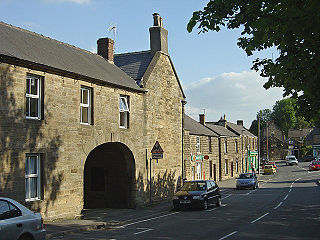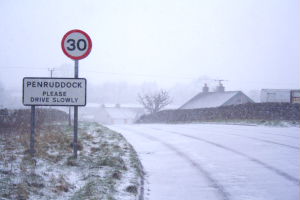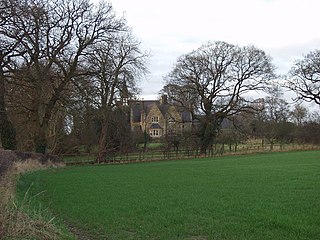 W
WCastle Bytham quarry is a disused quarry located close to the centre of the village of Castle Bytham, Lincolnshire, England. It is famous for the exposure of Laeviuscula Zone ammonite fauna has allowed the dating of the Upper Lincolnshire limestone formation to the Bajocian era, and thereby dating other deposits around Europe.
 W
WCocking Lime Works and its associated chalk quarry are abandoned industrial sites in the South Downs of England. They are to the south of the village of Cocking, West Sussex, close to the South Downs Way. The works are on land owned by the Cowdray Estate and are not open to the public. Cocking was the source of lime used for the manufacture of Midhurst White bricks and for agricultural purposes.
 W
WConsall is a small village situated in the Staffordshire Moorlands, Staffordshire, England. It is approximately 6 miles south of the market town of Leek and 8 miles east of Stoke-on-Trent. According to the last Census taken in 2001, Consall had a population of 118, increasing to 150 at the 2011 census.
 W
WCrich is a village in the English county of Derbyshire. The population at the 2001 Census was 2,821 increasing to 2,898 at the 2011 Census. It has the National Tramway Museum inside the Crich Tramway Village, and at the summit of Crich Hill above, a memorial tower for those of the Sherwood Foresters regiment who died in battle, particularly in World War I.
 W
WDrumhurrin, an Anglicisation of the Gaelic ‘Droim Shoirn’, meaning The Hill-Ridge of the Lime-Kiln or Furnace, is a townland in the civil parish of Templeport, County Cavan, Ireland. It lies in the Roman Catholic parish of Glangevlin and barony of Tullyhaw.
 W
WFin Cop is a hill and an associated Iron Age hill fort in Monsal Dale, close to Ashford in the Water in Derbyshire, England.
 W
WFroghall is a village situated approximately ten miles to the east of Stoke-on-Trent and two miles north of Cheadle in Staffordshire, England. Population details as taken at the 2011 Census can be found under Kingsley. Froghall sits in the Churnet Valley, a beautiful and relatively unspoilt part of Staffordshire. There are some excellent and challenging walks in the area, many of which encompass the area's historic development by the coal, ironstone, copper and limestone industries.
 W
WFurner's Green is a hamlet in the civil parish of Danehill in East Sussex, England.
 W
WThe Holy Island of Lindisfarne, commonly known as either Holy Island or Lindisfarne, is a tidal island off the northeast coast of England, which constitutes the civil parish of Holy Island in Northumberland. Holy Island has a recorded history from the 6th century AD; it was an important centre of Celtic Christianity under Saints Aidan of Lindisfarne, Cuthbert, Eadfrith of Lindisfarne and Eadberht of Lindisfarne. After the Viking invasions and the Norman conquest of England, a priory was reestablished. A small castle was built on the island in 1550.
 W
WLismore Seminary was situated in Kilcheran House on the island of Lismore in the Inner Hebrides part of Argyll, Scotland. It served as a seminary for the Roman Catholic Church in Scotland in the 19th century. At the time it was the only seminary in the west of Scotland and for the Vicariate Apostolic of the Highland District. The house still stands and has a lime kiln from the time of the seminary within the grounds. Both the house and the kiln are category B listed sites.
 W
WLunna House is a 17th-century laird's house on Lunna Ness in the Shetland Islands. Lunna House is noted for having "the best historic designed landscape in Shetland". In the 20th century it was used as a base of the wartime Shetland Bus operation.
 W
WThe Minera Limeworks were extensive lime quarries and kilns at Minera in Wrexham, Wales. It was located at grid reference SJ253520, near the villages of Gwynfryn, Minera, and Coedpoeth and was locally referred to as The Calch.
 W
WPenruddock is a small village in Cumbria, England, 5.5 miles to the west of Penrith. It forms part of the civil parish of Hutton.
 W
WPinxton is a village and civil parish in Derbyshire on the eastern boundary of Nottinghamshire, England, just south of the Pinxton Interchange at Junction 28 of the M1 motorway where the A38 road meets the M1. Pinxton is part of the Bolsover District and at the 2011 Census had a population of 5,699.
 W
WSt John's Gardens is an open space in Liverpool, England, to the west of St George's Hall. The gardens are part of the William Brown Street conservation area, and comprise one of the two open spaces within Liverpool's World Heritage Site. It has been a Green Flag site since 2003. The gardens contain ornamental flower beds, and memorials to notable people of the city.
 W
WTreborough is a small village and civil parish 7 miles (11 km) south of Dunster, lying amongst the Brendon Hills within the Exmoor National Park in the Somerset West and Taunton district of Somerset, England.
 W
WThe Trough of Bowland is a valley and high pass in the Forest of Bowland Area of Outstanding Natural Beauty, Lancashire, England.
 W
WTwiston is a village and a civil parish in the Ribble Valley District, in the English county of Lancashire. It is near the town of Clitheroe and the village of Downham. The parish is part of the Forest of Bowland Area of Outstanding Natural Beauty (AONB). It adjoins the Ribble Valley parishes of Downham and Rimington, and the Pendle parish of Barley-with-Wheatley Booth.
 W
WWallog is a beach on the coast of Cardigan Bay north of Aberystwyth between Clarach and Borth in the county of Ceredigion, Mid-Wales.
 W
WWatersmeet House is a National Trust property located some 1.8 miles (2.9 km) east of Lynmouth, in the English county of Devon. A former fishing lodge, it is today used as an information centre, tea room and shop by the National Trust. Adjoining the house is the Watersmeet SSSI, a Site of Special Scientific Interest.
 W
WWeston Lullingfields is a village in Shropshire, England. It is located about 15 km north west of Shrewsbury. The population as taken at the 2011 census can be found under Baschurch.
 W
WWouldham is a village on the bank of the River Medway in Kent, Great Britain. As of 2006 its population is approximately 1000 people, with the 11th-century church, one school, one village shop, and two public houses, The Medway Inn and The Waterman's Arms. The 3rd public house in the village- The Foresters Inn closed to the public in 2013.